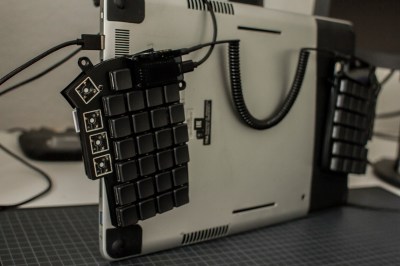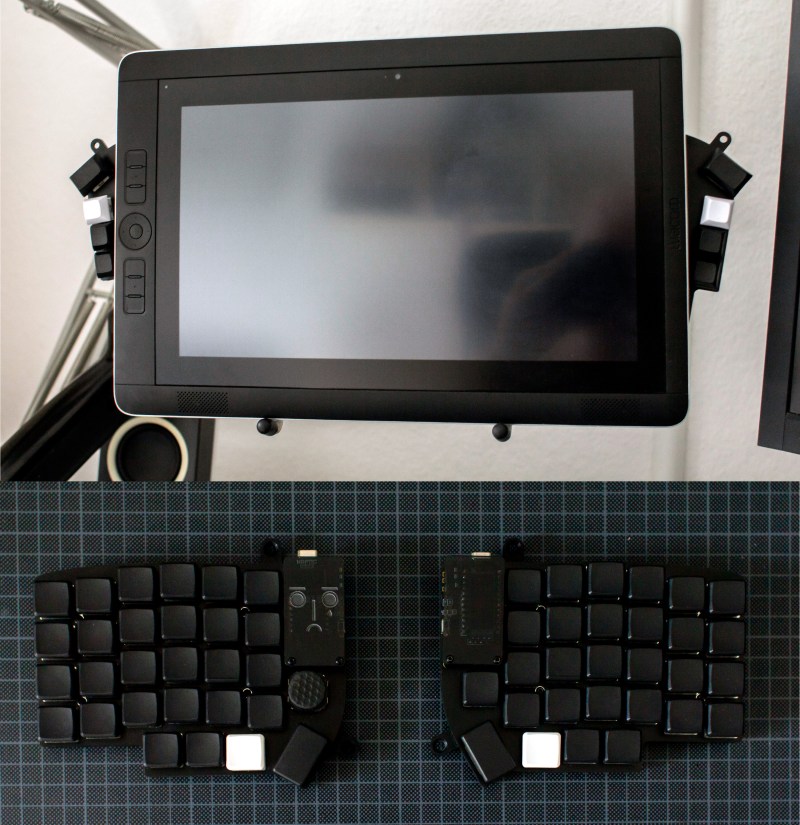A keyboard you build yourself should really be made just for you, and meet your specific needs. If you approach it this way, you will likely break ground and inspire others simply because it’s personalized. Such is the case with [_GEIST_]’s highly-customized lily58, designed to work in two modes — on the desk, and mounted on the back of a tablet.
 The lily58, which is a 58-key split with dual OLED footprints, was just a starting point for this build. For tablet mode, where the keyboard is attached to the back of a tablet with hook-and-loop tape, [_GEIST_] created custom plates that double the thumb keys on the back.
The lily58, which is a 58-key split with dual OLED footprints, was just a starting point for this build. For tablet mode, where the keyboard is attached to the back of a tablet with hook-and-loop tape, [_GEIST_] created custom plates that double the thumb keys on the back.
We love that there is a PSP thumbstick for mousing on one layer and inputting keystrokes on other layer. But we can’t decide which is our favorite part: the fact that [_GEIST_] threaded it through the bottom of a Kailh Choc switch, or the fact that there’s a Pimoroni Haptic Buzz with a different wave form for each layer. [_GEIST_] also added an acrylic middle plate layer to support quick-change magnetic tenting legs.
Keyboard mods don’t have to be involved to be adopted by others. This modified Dactyl adds custom wrist rest holders and has deeper bottoms that allow for less than perfect wiring.
Via reddit
















That’s a really nice form-factor that solves both the “Touchscreens are terrible because you occlude your interface” and “Keyboards take up too much face real estate” problems (and it looks like even mostly lets you exploit your qwerty muscle memory).
IIRC Microsoft Research was playing with a very similar scheme with RearType ( https://www.microsoft.com/en-us/research/publication/reartype-text-entry-using-keys-on-the-back-of-a-device/ ) about a decade ago but never commercialized it… I think this implementation may actually be more elegant than the prototypes from their publication.
I suppose in some sense people have been eyeing this approach forever, PARCTab, the granddaddy of mobile computing, did something similar with its edge-mounted chorder because the problem is obvious but hardware solutions never gain traction. Anything that gets us (back) away from trying to type on a touchscreen is progress, though.
Yeah, I considered it a year ago, but never had the guts to try.
https://forbot.pl/forum/uploads/monthly_2019_10/P1000768.JPG.77ec993f5aeffdb675fae3e02ece1e56.JPG
I’m happy to see someone did it.
Yeah real keyboards with tactile feedback are so superior, especially to those pesky tiny onscreen keyboards where hitting only the button you wanted (or having it even register the one you intended first) seems like a black art. Or a task only those of the dainty hand brigade can mange – my giant mitts are not what anybody would call clumsy, just rather to large for such tiny buttons…
I was thinking of a chording keyboard as it seems like the better behind the tablet approach ergonomically, though does mean learning to type again. But this looks like it could be good too, certainly an improvement on just the touch screen.
I periodically try to get a 7-key chorder (Mine is self-built, but it uses the same chord set as the Infogrip BAT) into my hands because the idea is so enticing, but my level of qwerty habituation means I’ve been trying off-and-on for years, I’m still slow, and it still makes my hands hurt as I twitch the qwerty motion then correct to the chord on my slightly-too-stiff-for-task switches.
The idea of doing a general-purpose chorder as a hand-held gadget, or around the edges of a device, or in something that can be clipped to a belt/pocket and rest neutrally on the leg is so high that I keep going back and trying when I have time. That little taste of sitting with my right hand on a trackball, my left hand on a chorder, and not moving anything but fingers to operate a machine is just so good.
I’d love to see this with some integrated ergonomic hand holds as well, so that it’s comfortable to hold the weight of the tablet and type/mouse at the same time.
Wow, thank you for the feature. I find a lot of useful posts here all the time.
Do you have this design up somewhere?
Looks very cool.
Are those low-profile switches? I like laptop-like keyboard keys, not those big mechanical ones everyone seems to use
The design is a Lily58, which you can find on Github or as a keyboard kit (just search for “Lily58 kit”). I just modified the keyboard plate and a middle layer. But if you’re interested I can upload the files somewhere.
The switches are Kailh Choc Low Profile switches. Built like regular mechanical switches, but as the name implies with a lower profile.